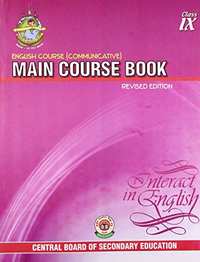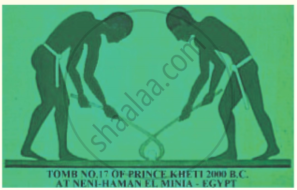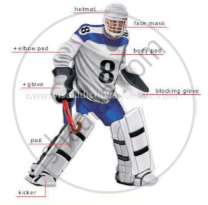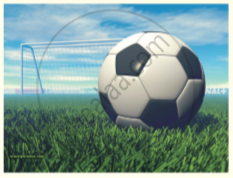Advertisements
Chapters
1.2: A Burglary Attempt
1.3: Can You Know People You Haven't Met
2.1: The Final Flight
2.2: The Sound of the Shell
2.3: Ordeal in the Ocean
3.1: The Indian Rhinoceros
3.2: Save Mother Earth
3.3: Save the Tiger
4.1: Radio Show
Chapter 4.2: Video Show
5.1: Bermuda Triangle
5.2: The Invisible Man
5.3: The Tragedy of Birlstone
5.4: Harry Potter
6.1: Tom Sawyer
6.2: Children of India
6.3: Children of Computer
6.4: Life Skills
6.5: We are the World
7.1: Grandmaster Koneru Humpy Queen of 64 Squares
7.2: It's Sports Day
▶ 7.3: Hockey and Foodball

Advertisements
Solutions for Chapter 7.3: Hockey and Foodball
Below listed, you can find solutions for Chapter 7.3 of CBSE CBSE for English Communicative - Main Course Book Interact in English Class 9.
CBSE solutions for English Communicative - Main Course Book Interact in English Class 9 7.3 Hockey and Foodball Exercise [Pages 150 - 155]
Read and enjoy :
Hockey 
Do you know when hockey was first played? Research in Ethiopia has discovered that it has been around for more than four millenia. A tablet in Greece has images of young people playing field hockey. Even in South America, Ireland, Egypt, Scotland and Rome, there are proofs and records of this game. The game in these countries was no different than the other even though it was known by different names. Hundreds of years ago, this game was known as 'Hockie' in Ireland and it is this name that has stuck with the game ever since.

While current field hockey appeared in the mid-18th century in England, primarily in schools, it was not until the first half of the 19th century that it became firmly established. Prior to 1980, women were not permitted to take part in this game. The first club was created in 1849 at Blackheath in south-east London. During the 1600s and 1700s, hockey in England was a little dissimilar and it was more disorganised. People from all over the village would take part in the game. It was not unusual for a team to have 60 - 100 players. It was the goal of the team players to get the ball into the common ground of the rival team. This game required quite a few days to finish. Many players suffered injuries. Even though umpires were present, they were not allowed to say anything without the team members' request.
Ultimaty , good judgment prevailed. Firm regulations were introduced. In England, a headmaster restricted the number of players to thirty for one single team, During the 1860s, England's Eton College laid down some rules for the game. Additional rules were introduced afterthe formation of the Hockey Association in the year 1875.
Football
Football refers to a number of similar team sports, all of which involve (to varying degrees) kicking a ball with the foot in an attempt to score a goal. People from around the world have played games which involved kicking and / or canying a ball, since ancient times. However, most of the modern codes of football have their origins in England.

The most popular of these sports worldwide is association football, more comm.only known as just 'Football' or 'Soccer'. It is widely considered to be the most popular sport in the world
Form pairs - one student will read the text for 'Hockey', and the second student will read the text for 'Football'.
Hockey

The game starts when the umpire blows his whistle for the opening pass-back. The passback is made at the centre of the field to start the game (also after half- time and after each goal is scored). The ball, which may be pushed or hit, must not be directed over the centre line. All players of the opposing team must stand at least 5 yard from the ball and all players of both teams, other than the player making the pass-back must be in their own half of the field.
There are two umpires to control the game and to administer the rules. These umpires are the sole judges of the game. The umpires are responsible for keeping time for the duration of the game.


In front of each goal is an area known as the penalty area. This is a rectangular area, 40.2m wide and extending 16. Sm into the field where the goalkeeper operates.
A standard adult football match consists of two periods of 45 minutes each, known as halves. Each half runs continuously, meaning that the clock is not stopped when the ball is out of play. There is usually a 15-minute half-time break between halves. The end of the match is known as full-time. Anytime during the match, a team can substitute upto three players maximum.
The game is controlled by a referee who is the official timekeeper for the match, and may make an allowance for time lost through substitutions, injured players requiring attention, or other stoppages. There are also two linesmen who keep guard of the touchlines or sidelines, signalling when the ball crosses the boundary lines. The referee alone signals the end of the match.
Handling the ball deliberately, pushing or tripping an opponent, or hitting a player from behind are examples of fouls, punishable by a direct free kick or penalty kick depending on where the offence occurred. Other fouls are punishable by an indirect free kick.
The referee may punish a player's or substitute's misconduct by a caution (yellow card) or sending-off (red card). A player is given a yellow card is said to have been 'booked'.
• Red - Serious misconduct resulting in ejection from the game. If a player has been sent off, no substitute can be brought in his place.
Each student will now complete his/her half of the following table (Hockey or Football), by adding information from the text each has read.
| Hockey | Football | |
| Ball : | ||
| Playing Area: | ||
| Duration : | ||
| Judging : | ||
| Penalties : | ||
| Penalty Area : | ||
| Cards : |
When both students have completed their half of the table above, exchange information, by asking and answering questions e.g.
1. What's the weight of the football?
2. When do you get a penalty in hockey?
As you receive information from your partner, write it down in the other half of the table above. (Do not let your partner look at your table!)
Either in groups or individually, make a power-point presentation on either of the two games. Incorporate points from the table above and any other interesting information I detail.
Your school is playing a football / hockey match with the neighbouring school. You are the official commentator for the match. Give a running commentary on the last few breathtaking minutes of the match.
OR
In groups of four, give a running commentary of the whole match. Each student must become the commentator at some point of time. (Your commentary should not be for more than three minutes)
Solutions for 7.3: Hockey and Foodball

CBSE solutions for English Communicative - Main Course Book Interact in English Class 9 chapter 7.3 - Hockey and Foodball
Shaalaa.com has the CBSE Mathematics English Communicative - Main Course Book Interact in English Class 9 CBSE solutions in a manner that help students grasp basic concepts better and faster. The detailed, step-by-step solutions will help you understand the concepts better and clarify any confusion. CBSE solutions for Mathematics English Communicative - Main Course Book Interact in English Class 9 CBSE 7.3 (Hockey and Foodball) include all questions with answers and detailed explanations. This will clear students' doubts about questions and improve their application skills while preparing for board exams.
Further, we at Shaalaa.com provide such solutions so students can prepare for written exams. CBSE textbook solutions can be a core help for self-study and provide excellent self-help guidance for students.
Concepts covered in English Communicative - Main Course Book Interact in English Class 9 chapter 7.3 Hockey and Foodball are Writing and Grammar, Reading, Literature Textbook and Extended Reading Text.
Using CBSE English Communicative - Main Course Book Interact in English Class 9 solutions Hockey and Foodball exercise by students is an easy way to prepare for the exams, as they involve solutions arranged chapter-wise and also page-wise. The questions involved in CBSE Solutions are essential questions that can be asked in the final exam. Maximum CBSE English Communicative - Main Course Book Interact in English Class 9 students prefer CBSE Textbook Solutions to score more in exams.
Get the free view of Chapter 7.3, Hockey and Foodball English Communicative - Main Course Book Interact in English Class 9 additional questions for Mathematics English Communicative - Main Course Book Interact in English Class 9 CBSE, and you can use Shaalaa.com to keep it handy for your exam preparation.
